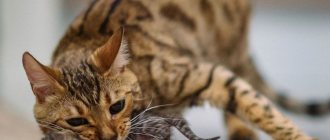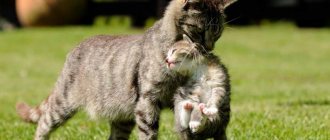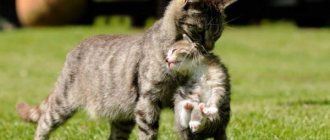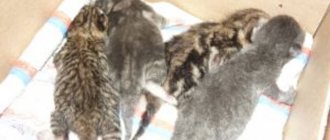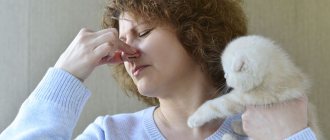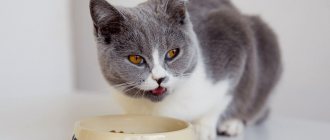Maternal instinct is an innate behavior pattern of an animal that ensures procreation. In cats, it usually works flawlessly. From the moment the cubs are born, mothers show maximum attention to the kittens, feeding them, washing them and protecting them from potential dangers. Often even from a person.
But, unfortunately, there are no rules without exceptions. Sometimes cats simply abandon their maternal responsibilities, dooming their newborns to starvation. But why does a cat leave newborn kittens? What principles underlie refusal of motherhood? And is it possible to save abandoned cubs if the mother cat still abandons them? First things first.
How to reduce the risk of abandonment of offspring
Try to follow the basic rules:
- the cat should have a warm and quiet place for giving birth and subsequent feeding of kittens;
- the cat should eat food high in nutrients;
- there is no need to touch kittens in the first two weeks of their life unless necessary;
- other pets should not have access to the cat with kittens, including the cat.
If the cat does abandon the little kittens, there are other possible reasons:
- the cat is too young and this is her first birth;
- too many kittens;
- after giving birth, the cat developed complications, for example, mastitis;
- the cat has no milk;
Contact your veterinarian for advice. Try to feed the cat food with a high content of nutrients, move her house to a quiet and peaceful place - perhaps after a short time the maternal instinct will kick in and she will return to her cubs.
Possible problems for a cat after giving birth
- Hormonal imbalance leading to disruption of lactation. After childbirth, alarming symptoms often appear, consisting in the inability to process glucose. This leads to a state of shock. The condition improves after injection with insulin, but it is better to get tested and consult a veterinarian;
- Stressful state. It arises due to human intervention (intentional or accidental). For example, in the first hours after birth, kittens were picked up and moved or the nest was moved. A change of bedding or furnishings, or bright light could frighten the young mother. The cat may eventually take back her offspring. In this case, the owner should try to provide comfort and, as soon as the young mother calms down and finds a closed place, she needs to put a nest with kittens there.
- Birth of non-viable kittens. It also happens that the offspring are too numerous, and the mother cat, feeling a lack of milk, does not feed the weak (but potentially having a chance to survive) babies. In this case, the owner has to provide assistance in caring for the offspring;
- Complicated childbirth and its consequences - endometritis, mastitis, etc. A cat does not think about its offspring if it feels pain, it only cares about its own condition. Some animals in a state of “postpartum insanity” may crush, tear to pieces or eat their babies.
- Too early (by cat standards) birth and pregnancy. The animal does not reach puberty and becomes pregnant. But it does not want to raise its offspring further.
- Lack of calcium or eclampsia is a dangerous condition for a young mother, requiring injections with the appropriate microelement and observation of the animal.
It may turn out that the reason for the reluctance to feed is a weak condition. If the cat rests, it will gain strength and begin to fulfill its duties towards the offspring.
There is no need to panic; it is better to provide the nurse with a large volume of liquid - milk, broth and water. Kittens need warmth while their mother is away. You will need a heating pad in soft fabric, which is placed in the nest. The cat needs to be calmed down, caressed, and treated to something tasty by all means.
How to feed a kitten
Unfortunately, such measures do not always lead to the return of the mother to her offspring. You will have to take on the responsibilities of being a mother. The best option would be to give the kittens to be raised by another cat that has just given birth. If you cannot find a nursing cat, you will have to try to feed the kittens at home.
- How to properly feed a kitten without a mother? First of all, you need to purchase a special mixture for newborn kittens at a pet store. The composition of such mixtures is very similar to mother's cat milk. Under no circumstances should you feed your kitten natural cow's milk: it is very different in composition from cat's milk and can lead to intestinal problems.
- Before feeding the kitten, you need to stimulate it: stroke its head, back, and tummy, imitating maternal licking.
- The temperature of the feeding mixture should be 36–38°C. Before feeding your kitten, place a drop of the mixture on your wrist to check the temperature. It is best to feed your kitten using a disposable syringe without a needle - this way you can control the portion size.
- In the first week of life, kittens need to be fed every 2 hours. In the second week, the frequency of feedings is reduced to 8 times a day. From the third week, kittens need to be fed only during the day, but at least 6 times a day.
- How much should a kitten eat? Pay attention to his behavior. A full-fed kitten falls asleep almost immediately. If there is not enough food, the kitten will continue to squeak and poke at your hands in search of a pacifier.
- After each feeding, the cat licks her litter to stimulate digestion and help the kittens go to the toilet. After each feeding, you will have to wipe the kitten's belly and butt with a soft cloth soaked in warm water.
Setting up a feeding area
The kitten definitely needs a permanent place that will serve as a dining room. Traditionally, it is located in the kitchen, in some secluded corner. However, it should be taken into account that neither the bowls nor the calmly dining animal should get in the way. Particular attention should be paid to the menu. Always have fresh water available. You can place a bowl of dry food next to the drinking bowl - the cat will be sure that at any moment she can go to the kitchen and have a snack. In the morning and evening, when you can throw away the leftovers and wash the dishes, you can give wet food. Moreover, it is desirable that it be of the same brand as dry. This will make your pet’s diet as balanced as possible. Of course, even the most delicious and expensive food will become boring, so you will have to change not only the types, but also the manufacturers. Also, do not forget to wash the bowl, even if the food is only dry.
Self-feeding kitten
At the age of three weeks, you can begin to introduce complementary foods into the kittens' diet. To avoid causing digestive disorders, portions should be very small, about the size of a pea.
What can and cannot be fed to kittens?
Can:
- food of soft and delicate consistency for kittens, preferably in the form of mousse.
It is forbidden:
- raw meat and fish;
- fatty, salty and fried foods;
- chocolate and sweets;
- food from your table.
How often should you give your kitten food? After introducing complementary foods, the frequency of feedings can be gradually reduced. In any case, consult your veterinarian regarding nutrition and introduction of complementary foods.
Is it possible to make a cat start feeding its offspring?
It is important to understand as soon as possible why a female cat refuses to feed her kittens.
What to do right away - contact the veterinarian with a house call. A veterinarian can make a diagnosis and prescribe treatment, including hormonal medications, if this is the problem. The animal should stop experiencing discomfort and pain, and normal lactation should begin.
If you are confident that labor will proceed normally, but the cat still refuses to feed the kittens, this is what you need to do.
If she does not show aggression towards the kittens, but simply does not pay attention to them, then you should sit (lay) her next to them and calmly stroke her, say something to your pet in a calm voice - and at the same time put one kitten under her side...
Newborns should not be handled with bare hands, so as not to be additionally “stained” with human odor - it is better to handle them with a hand wearing a medical glove.
We invite you to familiarize yourself with Devon Rex cat breed photo
In order for the cat to recognize the kittens as her offspring, they can be “marked” by smearing a little mother’s milk (if it appears on the cat’s nipples) or her urine on each fur. Sometimes there are also tips to drop a little of the cat’s favorite treat on the newborn “refuser” kitten - for example, sour cream, so that she starts licking the kitten, licking the sour cream.
Creating conditions for kittens
To raise a kitten without a cat, you will have to replace the mother not only in the feeding process. You need to provide the kittens with a place to sleep and play, learn how to wash the kitten, and give it a massage.
- A place to sleep. You can use a small box as a sleeping place. Place soft cloths, baby diapers or towels there. During the first weeks of life, the temperature of the kittens' bed should be similar to the mother cat's body temperature. The room temperature will need to be maintained at 29-32°C, then gradually reduced to 24°C. If kittens are cold, use a warm water bottle or a small heater as a heating pad. The sleeping area should be clean, so wash the bedding promptly, being careful not to use chemical cleaners.
- Washing and massage. It is best to wash the kitten with a cotton pad or soft cloth soaked in warm water. When washing, imitate the movements of a mother cat - move along the kitten’s fur in one direction, from top to bottom. Before and after each feeding, it is necessary to massage the kitten's tummy to stimulate digestion and bowel movements.
Instinct with damage
There are cats whose hunting instinct is poorly developed and they do not catch mice. And there are those whose maternal instinct is poorly developed. Of course, there are few of these, because this is, in fact, a mistake of nature, but such cats still exist.
Whatever the reason why the cat abandons the kittens and leaves, you should not scold or hit her, this will only make the situation worse. A sick animal must be treated. In other cases, you can try to “reconcile” the mother and cubs by calming the cat down, talking kindly to her and expressing your approval in every possible way.
If this does not help, there is only one thing left to do - find a nurse for the “orphans” or take on maternal responsibilities. But this is a topic for another discussion.
Visits to a veterinarian
If you have any questions about caring for kittens, please contact your veterinarian. He will tell you all the nuances, talk about vaccinations and check the pet’s health. Be sure to visit the clinic if something in the kitten’s behavior or appearance confuses you. Reasons for visiting a veterinarian may include discharge from the kitten's eyes or nose, unusual lethargy, lack of appetite, unusual stool, and injuries.
Caring for newborn kittens is a difficult and responsible task, but with proper attention and patience, you will be able to feed and raise them.
Treatment and prevention
Few people think about whether a cat can eat a kitten. This behavior is not normal and is considered pathological. There is no specific treatment.
Some veterinarians believe that maternal aggression is genetically transmitted
It is advisable to remove from breeding a cat that has at least once engaged in cannibalism. You can check her hormone levels, but the correction is difficult and long. Therefore, it is better to sterilize the female and not allow her near the kittens.
If your cat shows anxiety or aggression at the sight of newborn babies, you can give her mild sedatives. Sometimes the animal calms down when the “nest” is placed in a dark and closed room.
It is not always clear why a cat eats kittens. This behavior is considered strange and atypical. In some cases, aggression may appear only towards cubs that are 2-3 months old. This behavior is normal, since parents always drive their offspring away from their territory. At this age, kittens can already arrange their lives on their own.
Sick or stranger
Everyone knows that under no circumstances should you handle baby wild animals: because of the foreign smell, the mother will abandon such a baby. But for some reason, few people think that this may be the reason why the cat leaves - kittens, even newborns, are often picked up and squeezed in the most unceremonious way. If babies lose their mother's scent, there is a very high probability that the mother will abandon them.
Rules for caring for babies
Kittens left without a mother must not only be fed, observing all the necessary requirements, but also warmed. Thermoregulation of newborns practically does not work, and they often die not so much from hunger as from low ambient temperatures. Under no circumstances should fluffy balls be allowed to become hypothermic even for a short time. Therefore, in addition to feeding, the owner must take care of maintaining the temperature regime for the babies.
The best solution would be to purchase an electric mattress, rug, blanket, and heating pad with adjustable temperature. An ordinary rubber heating pad with water is only suitable as an emergency measure for a short period of time.
- In the first week of life, the ambient temperature should be 29-320 C.
- In the second week – 27-290 C.
- Then the temperature is reduced by 2 - 3 degrees every week.
You should also know that not only low but also high temperatures are detrimental to kittens. Therefore, babies should not be overheated.
No milk
For example, due to a hormonal imbalance caused by childbirth, the animal simply does not produce milk. The same thing happens to cats after anesthesia for caesarean section. Lack of lactation is one of the reasons why a cat leaves newborn kittens.
Also, in cats that have recently given birth (especially in very young and, conversely, older cats), endometritis often occurs - inflammation of the uterine mucosa. In this case, mothers simply lose milk, and they run away from their babies or throw them out of the “nest”: this is what nature dictates.
In addition, mother cats often experience mastitis, that is, inflammation of the mammary glands, and the feeding process becomes so painful that they have no choice but to escape from the kittens and from the painful sensations.
[custom_ads_shortcode3]

